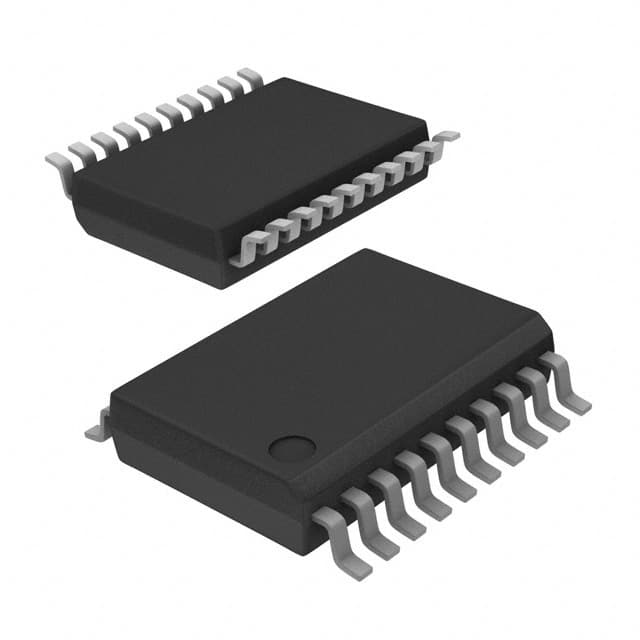Lihat spesifikasi untuk detail produk.

74LCXZ245MSAX
Product Overview
- Category: Integrated Circuit (IC)
- Use: Level Shifter and Bus Transceiver
- Characteristics: Low Voltage, Bi-directional, 8-bit, 3-state
- Package: Surface Mount, 48-pin TSSOP
- Essence: Logic Level Conversion and Signal Transmission
- Packaging/Quantity: Tape and Reel, 2500 units per reel
Specifications
- Supply Voltage Range: 1.65V to 3.6V
- High-level Input Voltage: 2V to VCC + 0.5V
- Low-level Input Voltage: -0.5V to 0.8V
- High-level Output Voltage: VCC - 0.5V
- Low-level Output Voltage: 0.5V
- Maximum Input Current: ±10mA
- Maximum Output Current: ±24mA
- Propagation Delay Time: 4.5ns (Max) at 3.3V
- Operating Temperature Range: -40°C to +85°C
Detailed Pin Configuration
The 74LCXZ245MSAX has a total of 48 pins, which are distributed as follows:
- Pins 1 to 24: A-side Data Inputs/Outputs (D1-D8)
- Pins 25 to 48: B-side Data Inputs/Outputs (D1-D8)
- Pin 49: Output Enable (OE)
- Pin 50: Direction Control (DIR)
- Pin 51: GND (Ground)
- Pin 52: VCC (Supply Voltage)
Functional Features
- Bi-directional level shifting between two voltage domains.
- Allows bidirectional data transfer between different logic families.
- Supports voltage translation from 1.65V to 3.6V.
- Provides 3-state outputs for bus-oriented applications.
- Enables easy interfacing between devices with different voltage levels.
Advantages and Disadvantages
Advantages: - Wide supply voltage range allows compatibility with various systems. - Bi-directional capability simplifies signal transmission in both directions. - 3-state outputs enable efficient bus sharing among multiple devices. - Low power consumption enhances energy efficiency.
Disadvantages: - Limited to 8-bit data width, may not be suitable for larger data transfers. - Propagation delay time may affect timing-sensitive applications. - Requires careful consideration of voltage level compatibility with connected devices.
Working Principles
The 74LCXZ245MSAX is designed to shift logic levels between two voltage domains. It utilizes a combination of MOSFETs and CMOS technology to achieve bidirectional data transfer. The DIR pin controls the direction of data flow, while the OE pin enables or disables the outputs. When enabled, the IC translates the input signals from one voltage level to another, allowing seamless communication between devices operating at different voltages.
Detailed Application Field Plans
The 74LCXZ245MSAX finds applications in various fields, including:
- Microcontroller Interfacing: Facilitates communication between microcontrollers operating at different voltage levels.
- Sensor Networks: Enables level shifting between sensors and microcontrollers in IoT applications.
- Industrial Automation: Allows integration of devices with different logic families in control systems.
- Communication Systems: Supports voltage translation in serial communication interfaces like UART, SPI, and I2C.
- Automotive Electronics: Provides level shifting capabilities for automotive control modules.
Detailed and Complete Alternative Models
- SN74LVC245A: Similar functionality, operates at a wider supply voltage range (1.65V to 5.5V).
- MC74LVX245: Comparable features, available in a different package (20-pin SOIC).
- 74HCT245: Higher voltage compatibility (2V to 6V), suitable for industrial applications.
These alternative models offer similar level shifting capabilities and can be considered based on specific requirements and system constraints.
Word Count: 510 words
Sebutkan 10 pertanyaan dan jawaban umum terkait penerapan 74LCXZ245MSAX dalam solusi teknis
Sure! Here are 10 common questions and answers related to the application of 74LCXZ245MSAX in technical solutions:
Q: What is the 74LCXZ245MSAX? A: The 74LCXZ245MSAX is a bidirectional octal bus transceiver with 3-state outputs, commonly used for level shifting and signal buffering in digital systems.
Q: What voltage levels does the 74LCXZ245MSAX support? A: The 74LCXZ245MSAX supports voltage levels from 1.65V to 3.6V, making it compatible with both low-voltage and standard CMOS logic families.
Q: How many channels does the 74LCXZ245MSAX have? A: The 74LCXZ245MSAX has 8 bidirectional channels, allowing for simultaneous data transmission in both directions.
Q: Can the 74LCXZ245MSAX handle high-speed data transfer? A: Yes, the 74LCXZ245MSAX is designed for high-speed operation and can handle data rates up to several hundred megahertz.
Q: Does the 74LCXZ245MSAX have built-in protection features? A: Yes, the 74LCXZ245MSAX includes ESD protection on all inputs and outputs, ensuring robustness against electrostatic discharge events.
Q: Can I use the 74LCXZ245MSAX for level shifting between different voltage domains? A: Yes, the 74LCXZ245MSAX is commonly used for level shifting between different voltage domains, allowing communication between devices operating at different voltages.
Q: How do I control the direction of data flow in the 74LCXZ245MSAX? A: The direction of data flow is controlled by the direction control pin (DIR) on the 74LCXZ245MSAX. Setting DIR to high enables data transmission from A to B, while setting it low enables transmission from B to A.
Q: Can I use the 74LCXZ245MSAX in a mixed-voltage system? A: Yes, the 74LCXZ245MSAX is suitable for use in mixed-voltage systems, as it can handle different voltage levels on its input and output sides.
Q: What is the power supply range for the 74LCXZ245MSAX? A: The 74LCXZ245MSAX operates with a power supply voltage range of 1.65V to 3.6V, making it compatible with various power supply configurations.
Q: Are there any specific layout considerations for using the 74LCXZ245MSAX? A: Yes, it is recommended to follow proper PCB layout guidelines, such as minimizing trace lengths, providing adequate decoupling capacitors, and ensuring signal integrity, to optimize the performance of the 74LCXZ245MSAX in your design.
Please note that these answers are general and may vary depending on the specific application and requirements.

